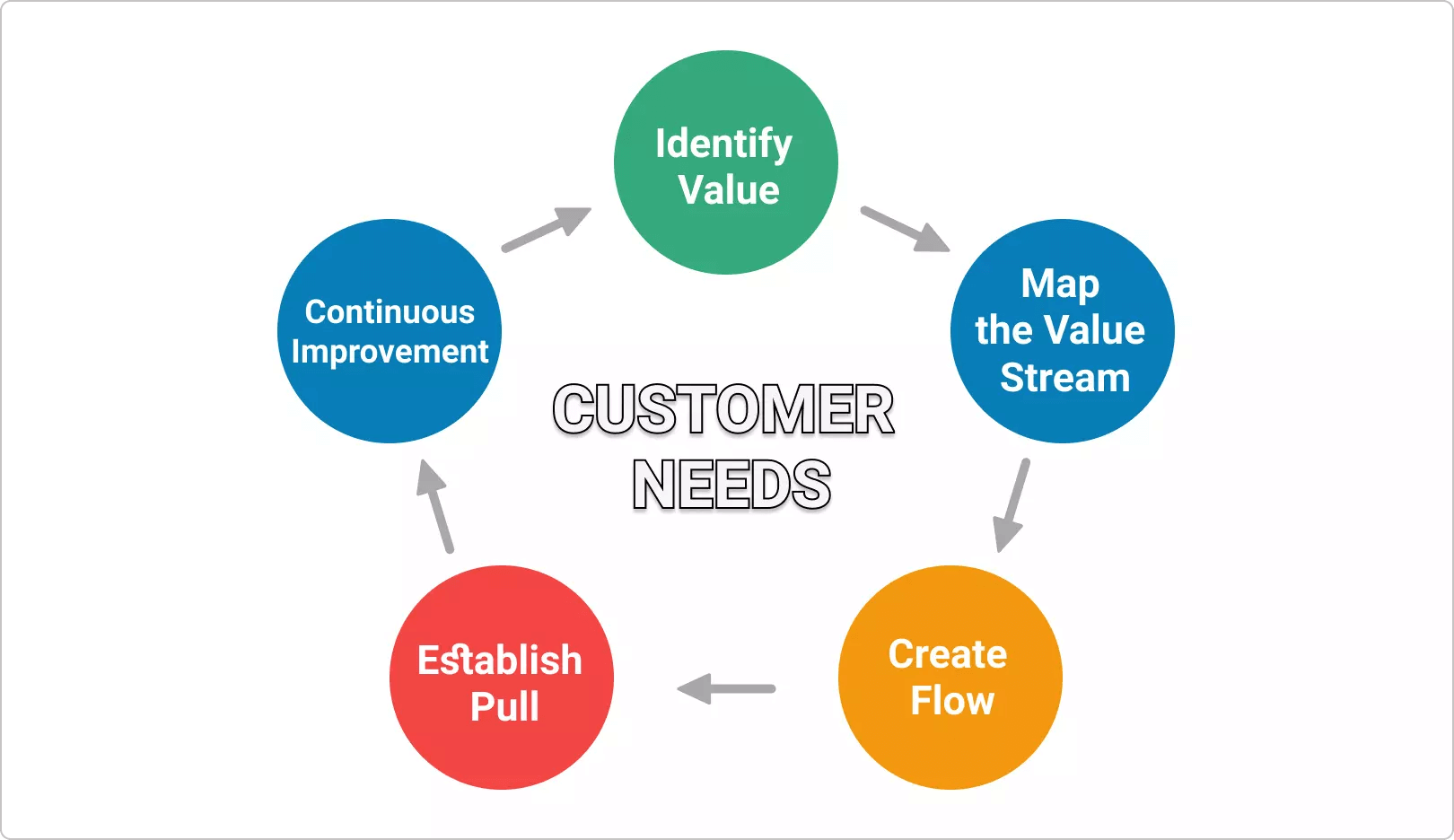The rising success of Lean Manufacturing has been well-recognized in businesses for years now. Its core strategy for cultivating a culture of continuous improvement for business growth has been adopted by organizations from all sectors. With its techniques and tools to reduce waste and increase quality, the Lean manufacturing concept has been yielding notable results.
This practical guide covers the Lean manufacturing principles, how its history unfolded, the goals and benefits it can bring, and how to apply it in practice.
What Is Lean Manufacturing?
Lean manufacturing is a production method designed to help reduce both the time for production, as well as response times to customers and suppliers. The strategy aims to increase efficiency by eliminating waste, optimizing processes, and cutting costs. The practice allows for reducing waste and inventory costs by producing only what’s in demand and not overstocking. By reducing the production time, the method improves the productivity rate and helps increase profits.
What Is the History of Lean Manufacturing?
The method, also known as lean production or just-in-time production (JIT), dates back to the late 1940s when Toyota developed its operating model called Toyota Production System (TPS). Later on, in 1988, John Krafcik established the term “lean”.
The emergence of the lean manufacturing principles is attributed to James Womack and Daniel Jones, who defined the method’s 5 principles in 1996: value specification; mapping the value stream; creating value flow; establishing a pull system; pursuing perfection. The principles forming a production cycle are the heart of Lean philosophy and Lean thinking.
Originating in the manufacturing world, today the method is successfully applied as a management method across industries and domains.
What Is the Toyota Production System (TPS)?
The Toyota Production System (TPS) or “The Toyota Way” is an operational model which emerged in the early 20th century in Japan as a management system for organizing manufacturing and logistics processes. The backbone of TPS is the just-in-time production (JIT) system, created by Mr. Taiichi Ohno (a Japanese industrial engineer and businessman).
The two Lean pillars of the Toyota Way are continuous improvement and respect for people. They are foundational to the understanding of what lean manufacturing is all about and where its principles are derived from.
The core purpose of just-in-time production as a part of TPS is to remove all wasteful activities from the processes. By reducing and eliminating non-value-adding activities (wastes) from production, the method aims to achieve continuous improvement. For instance, if you work in an environment where changeover times are significant, and there are multiple job classifications, applying the JIT system would mean looking for ways to reduce changeover times and eliminating job classifications. By doing so, you not only provide greater flexibility for the people, but you are also empowering their ability to use their full potential instead of doing the same thing over and over.
What Are the Key Principles of Lean Manufacturing?
Understanding the five principles of Lean management is crucial to successfully applying Lean. They include:
-
Identify value: Specify what is the specific value that the customer desires.
-
Map the value stream: Identify the value stream cycle for each product or service providing value to your customers and remove the ones that don’t add value.
-
Create flow: Once the value-adding steps are identified, aim to create a continuous flow of value in your process.
-
Establish a pull system: Allow people to pull work instead of pushing work on them.
-
Pursue perfection: Continuously improve to reduce the time and steps required to deliver value to your customers.
 The five principles of Lean management
The five principles of Lean management
At its core, Lean manufacturing is defined as the production strategy to reduce times for delivery and response to customers’ inquiries. It does that by eliminating all processes which don’t bring value.
How to Implement Lean Manufacturing in 3 Steps?
Lean Manufacturing requires a few steps to be followed for successful implementation. Through the use of techniques such as mapping the value stream and establishing a pull-based production system, you are ready to start practicing Lean.
1. Visualize the Entire Value Stream Process
Value stream mapping is the Lean practice of visualizing all necessary steps in a work process for delivering value to the customer. The technique allows you to represent every stage and work item in your process visually. By doing so, through value stream mapping you can easily identify and eliminate wasteful steps and activities and redesign your process to achieve a healthy flow of work.
2. Establish a Demand-based Work System
Establishing a pull system is one of the Lean manufacturing principles designed to help reduce waste from the production processes. The term refers to committing to work only when there is an actual demand for it. The practice of pull allows you to optimize your resources, reduce overstocking and deliver faster.
3. Seek Continuous Improvement
Continuous improvement is a foundational part of the Lean culture. The commitment to always be on the lookout for better ways to do work is an essential part of what Lean production teaches. All organizational efforts are focused to increase customer satisfaction, eliminate waste, and optimize work processes through constant examination of how to process work. Continuous improvement allows you to improve the quality and flow of work, simplifying work processes, reducing waste such as defects, among other benefits.
What Are the Goals of Lean Manufacturing?
Among the most prominent objectives of the Lean manufacturing method is creating efficiency through continuously examining the current processes and improving them. To achieve this, Lean has 4 different goals.
- To improve the quality of delivered value (products or services).
- To reduce delivery times and times to respond to customer requests.
- To optimize work processes by eliminating waste (non-value-adding steps).
- To reduce costs by meeting customer demands with as few resources as needed.
What Are the Advantages of Lean Manufacturing?
Before jumping to implement Lean manufacturing in your business, analyzing the advantages of the production methodology is crucial to align your expectations with reality. Along its evolution path, the method has proven its potential to bring:
- Improved quality performance
- Streamlined processes
- Increased productivity
- Increased employee satisfaction and morale
- Increased profits
- Reduced production and response time
- Eliminate waste
What Are the Disadvantages of Lean Manufacturing?
Once the advantages are cleared out, examining the disadvantages of Lean manufacturing will remove all doubt about whether the method would fit your needs or not. Some of the most common drawbacks of Lean are related to:
- Equipment failure
- Supplier issues
- Lack of acceptance by employees
- High implementation cost
What Are the Types of Waste in Lean Manufacturing?
Eliminating waste is an integral part of what Lean manufacturing actually is. Following the Lean guidelines means eliminating, reducing, and simplifying work processes. There are seven types of waste of Lean that should be eliminated from the workflow through continuous improvement.
1. Overproduction
Overproduction is a type of waste in Lean manufacturing that refers to producing or generating work in excess of what is in demand which leads to additional costs for transportation, resources, waiting time, rework, etc.
2. Inventory
The inventory type of waste is related to an excessive overstocking of materials or resources to meet unexpected customer demands. However, in most cases, the end result of this inventory is increased storage costs and no added value for customers.
3. Motion
The motion waste type refers to any unnecessary movement of people or equipment which affects production time, the safety of the working environment, and workplace organization. This can include moving, lifting, reaching, etc.
4. Defects
Defects are a type of Lean manufacturing waste that refers to any product or service which is not fit for use and requires rework or scrapping altogether. All defects lead inevitably to additional costs and do not add value to the customers.
5. Over-processing
The waste refers to all excess work that is not required by the customer and leads to additional costs and spending of resources. The result is an increased end price a customer may not be willing to pay for. This can be an additional product functionality or adding more steps in a workflow process.
6. Waiting
Waiting is a type of waste in Lean manufacturing that refers to any type of service which is not in motion: waiting on materials or suppliers, equipment waiting to be fixed, people waiting on approval, etc.
7. Transport
Transport waste in Lean manufacturing refers to any excessive movement of materials or resources which turns out costly, can negatively affect the quality, and does not add value to the end product.
Industries Where Lean Мanufacturing Finds Application
Originating as a way to reduce waste and improve production times in the manufacturing world, the production methodology is nowadays successfully applied in a number of domains. Thanks to its universally relevant attributes: continuous improvement and respect for people, we can see today lean manufacturing thriving in:
- Healthcare
- Software development
- Project management
- Construction
- Banking
- Education
What Are the Best Lean Manufacturing Tools?
Lean manufacturing offers the use of multiple tools and techniques to achieve the goals you set out to achieve. Depending on your business environment, the most suitable Lean manufacturing tools may differ. Here’s a handful of the most popular, useful, and widely applied tools:
-
Kanban (Workflow management method focusing on optimizing work delivery across teams and organizational levels)
-
Kaizen (Continuous improvement approach)
- Value Stream Mapping (Lean management tool used to visualize, analyze and improve all the steps of the delivery process)
-
5S method (A Lean method for workspace optimization to achieve maximum process efficiency)
- Plan-Do-Check-Act (PDCA) (A problem-solving iterative method for improving processes and products continuously)
-
Heijunka (A Lean method for leveraging production)
-
Poke-Yoke (An error and defects proofing system)
-
Jidoka (A Lean method for ensuring built-in quality)
-
Andon (A production system errors alert system)
Lean Manufacturing Examples
Even though it originates from the automotive industry, today, Lean production principles expand well outside the manufacturing realm. The application of the Lean manufacturing concept can take a variety of forms in today’s reality. Here are a few examples:
- Truck Manufacturing: Improving production levels and efficiency.
- Customer Service: Streamlining the work process by mapping the value stream.
- Process Automation: Improving transparency and flow tracking.
-
Innovation culture: Improving learning and knowledge sharing.
Lean vs. Six Sigma
The difference between Lean and Six Sigma lies in the different approaches they use to achieve their goals. While Lean focuses on removing waste from a process and achieving improvement, Six Sigma seeks to identify and remove causing issues by using more statistical and graphical tools.
Despite this, both methods seek to improve production processes by detecting defects on time, eliminating waste, and providing the best quality. They successfully complement each other in identifying the defects' root causes and together form a data-driven approach called Lean Six Sigma.
What Are the Best Books for Lean Manufacturing?
The evolutionary nature of Lean manufacturing offers extensive literature, both theoretical and practical. Some of the best books for lean manufacturing are listed below:
- “Toyota Production System, Beyond Large Scale Production”, Taiichi Ohno, 1978
- “A revolution in manufacturing”, Shigeo Shingo, 1985
- “Just-In-Time for Today and Tomorrow”, Setsuo Mito, Taiichi Ohno, 1988
- “The Machine That Changed the World”, Daniel Roos, Daniel Jones, James Womack, 1990
- “Lean Thinking: Banish Waste and Create Wealth in Your Corporation”, James Womack, Daniel Jones, 1996
We offer the most flexible software platform
for outcome-driven enterprise agility.
In Summary
The Lean manufacturing production method is designed to help reduce both the time for production and response times to customers and from suppliers. The method relies on five key principles.
- Identify value.
- Map the value stream.
- Create flow.
- Establish a pull system.
- Pursue perfection.





 The five principles of Lean management
The five principles of Lean management 


